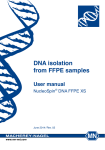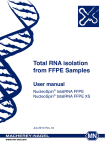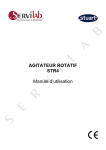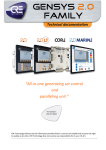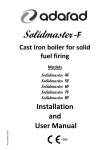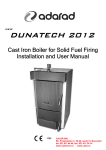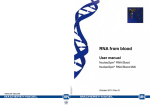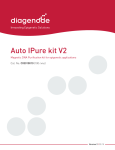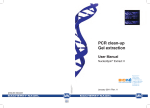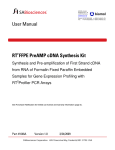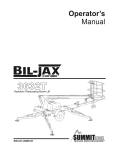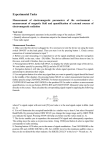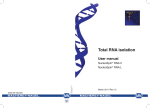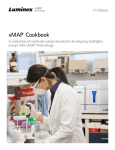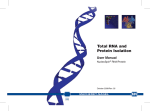Download NucleoSpin® FFPE RNA/DNA
Transcript
RNA and DNA Isolation from FFPE Samples User Manual A025755 R11en1/4/0/01.10 Printed in Germany NucleoSpin® FFPE RNA/DNA www.mn-net.com MACHEREY-NAGEL July 2010 / Rev. 02 MACHEREY-NAGEL MACHEREY-NAGEL MN EN ISO 9001: 2008 CERTIFIED RNA and DNA Isolation from FFPE Samples Protocol-at-a-glance (Rev. 02) NucleoSpin® FFPE RNA/ DNA Protocol 5.1: RNA and DNA isolation with Paraffin Dissolver 1 Deparaffinize sample Protocol 5.3: RNA and DNA isolation with xylene 400 µl Paraffin Dissolver 1 ml xylene 60 °C, 3 min Mix hot sample RT, 2 min Mix Let sample cool down Full speed, 2 min Discard supernatant 1 ml ~ 98% ethanol Mix Full speed, 2 min Discard supernatant Dry at 60°C, 3 – 10 min 2 3 Lyse sample 100 µl FL Decrosslink 100 µl FL 11,000 x g, 1 min – 10 µl Proteinase K Mix 10 µl Proteinase K Mix RT, 3 hours RT, 3 hours 100 µl D-Link Mix gently 11,000 x g, 30 s 100 µl D-Link Mix gently 90°C, 15 min 90°C, 15 min – 4 Adjust binding condition 200 µl ~ 98 % ethanol Mix 11,000 x g, 30 s 200 µl ~ 98 % ethanol Mix – 5 Bind RNA/ DNA Load aqueous (lower) phase Load lysate 6 a Wash and dry silica membrane 2,000 x g, 30 s 2,000 x g, 30 s 1st 100 µl DNA Wash 11,000 x g, 30 s 100 µl DNA Wash 11,000 x g, 30 s 2nd 100 µl DNA Wash 11,000 x g, 2 min 100 µl DNA Wash 11,000 x g, 2 min 20 µl DNA Elute RT, 2 min 11,000 x g, 30 s 20 µl DNA Elute RT, 2 min 25 µl DNase mixture RT, 15 min 25 µl DNase mixture RT, 15 min 100 µl FW1 RT, 2 min 11,000 x g, 30 s 100 µl FW1 RT, 2 min 11,000 x g, 30 s 2nd 400 µl FW2 11,000 x g, 30 s 400 µl FW2 11,000 x g, 30 s 3rd 200 µl FW2 11,000 x g, 2 min 200 µl FW2 11,000 x g, 2 min 10 µl RNase-free H2O 10 µl RNase-free H2O 11,000 x g, 30 s 11,000 x g, 30 s 6 b Elute DNA 6 c Digest residual DNA 7 8 Wash and dry silica membrane Elute highly pure RNA 1st 11,000 x g, 30 s MACHEREY-NAGEL GmbH & Co. KG • Neumann-Neander-Str. 6-8 • D-52355 Düren • Germany Tel.: +49 (0) 24 21 969 270 • www.mn-net.com • e-mail: [email protected] MN RNA Isolation from FFPE Samples Protocol-at-a-glance (Rev. 02) NucleoSpin® FFPE RNA/ DNA Protocol 5.2: RNA isolation with Paraffin Dissolver 1 Deparaffinize sample Protocol 5.4: RNA isolation with xylene 400 µl Paraffin Dissolver 1 ml xylene 60 °C, 3 min Mix hot sample RT, 2 min Mix Let sample cool down Full speed, 2 min Discard supernatant 1 ml ~ 98 % ethanol Mix Full speed, 2 min Discard supernatant Dry at 60°C, 3 – 10 min 2 3 Lyse sample 100 µl FL Decrosslink 4 Adjust binding condition 5 Bind RNA 6 a Desalt silica membrane 8 Wash and dry silica membrane Elute highly pure RNA – 10 µl Proteinase K Mix 10 µl Proteinase K Mix 60°C, 15 min – 3 hours 60°C, 15 min – 3 hours 100 µl D-Link Mix gently 11,000 x g, 30 s 100 µl D-Link Mix gently 90°C, 15 min 90°C, 15 min 200 µl ~ 98 % ethanol Mix 11,000 x g, 30 s 200 µl ~ 98 % ethanol Mix – – Load aqueous (lower) phase Load lysate 2,000 x g, 30 s 2,000 x g, 30 s 100 µl MDB 100 µl MDB 11,000 x g, 30 s 11,000 x g, 30 s 25 µl rDNase mixture RT, 15 min 25 µl rDNase mixture RT, 15 min 100 µl FW1 RT, 2 min 11,000 x g, 30 s 100 µl FW1 RT, 2 min 11,000 x g, 30 s 2nd 400 µl FW2 11,000 x g, 30 s 400 µl FW2 11,000 x g, 30 s 3rd 200 µl FW2 11,000 x g, 2 min 200 µl FW2 11,000 x g, 2 min 10 µl RNase-free H2O 10 µl RNase-free H2O 11,000 x g, 30 s 11,000 x g, 30 s 6 b Digest DNA 7 100 µl FL 11,000 x g, 1 min 1st MACHEREY-NAGEL GmbH & Co. KG • Neumann-Neander-Str. 6-8 • D-52355 Düren • Germany Tel.: +49 (0) 24 21 969 270 • www.mn-net.com • e-mail: [email protected] MN Nucleic Acid Isolation from FFPE Samples Table of contents 1 2 Components 4 1.1 Kit contents 4 1.2 Reagents, consumables, and equipment to be supplied by user 5 1.3 About this User Manual 5 Product description 6 2.1 The basic principle 6 2.2 Kit specifications 7 2.3 Handling, preparation, and storage of starting materials 8 2.4 Quantities of FFPE sections 9 2.5 Elution procedures 9 2.6 Stability of isolated RNA 10 2.7 Stability of isolated DNA 10 3 Storage conditions and preparation of working solutions 11 4 Safety instructions – risk and safety phrases 13 5 Protocols 15 5.1 RNA and DNA purification from FFPE samples using Paraffin Dissolver 15 6 5.2 RNA purification from FFPE samples using Paraffin Dissolver 21 5.3 RNA and DNA purification from FFPE samples with xylene deparaffinization 26 5.4 RNA purification from FFPE samples with xylene deparaffinization 31 5.5 Support protocol NucleoSpin® FFPE RNA/ DNA: DNA digestion in the RNA eluate 36 Appendix 37 6.1 Comments on RNA quality and quantity 37 6.2 Troubleshooting 38 6.3 Ordering information 42 6.4 References 43 6.5 Product use restriction / warranty 43 MACHEREY-NAGEL – 07 / 2010, Rev. 02 3 Nucleic Acid Isolation from FFPE Samples 1 Components 1.1 Kit contents NucleoSpin® FFPE RNA/ DNA 10 preps 50 preps 250 preps 740978.10 740978.50 740978.250 5 ml 25 ml 125 ml Lysis Buffer FL 1.8 ml 8 ml 30 ml Decrosslink Buffer D-Link 1.8 ml 8 ml 30 ml Wash Buffer FW1 2 x 1 ml 15 ml 2 x 15 ml Wash Buffer FW2 (Concentrate)* 2 ml 7 ml 2 x 20 ml Membrane Desalting Buffer MDB 1.8 ml 10 ml 50 ml Reaction Buffer for rDNase 0.5 ml 3 ml 20 ml 1 vial (size A) 1 vial (size C) 2 vials (size D) Proteinase K (lyophilized)* 6 mg 30 mg 75 mg Proteinase Buffer PB 0.8 ml 1.8 ml 8 ml 2 ml 4 ml 12 ml 1.2 ml 6 ml 3 x 6 ml 5 ml 15 ml 25 ml NucleoSpin® FFPE Columns (light blue rings plus Collection Tubes) 10 50 250 Collection Tubes (2 ml) 20 2 x 50 2 x 250 Collection Tubes (1.5 ml) 10 50 250 User Manual 1 1 1 Cat. No. Paraffin Dissolver rDNase, RNase-free (lyophilized)* DNA Wash (Concentrate)* DNA Elute RNase-free H2O * For preparation of working solutions and storage conditions see section 3. 4 MACHEREY-NAGEL – 07 / 2010, Rev. 02 Nucleic Acid Isolation from FFPE Samples 1.2 Reagents, consumables, and equipment to be supplied by user Reagents • 96 – 100 % ethanol (to adjust binding conditions and to prepare Wash Buffer FW2, undenaturated is preferable) • 50 % ethanol (to prepare DNA Wash, undenaturated is preferable) • Optional for deparaffinization without Paraffin Dissolver: Xylene, or d-Limonene (e.g., Roti®-Histol, Hemo-De), or mixtures of isoparafinic hydrocarbons (e.g., Roticlear®, Micro-ClearTM, Neo-Clear®). Consumables • 1.5 ml microcentrifuge tubes (for sample lysis and DNA elution) • Disposable pipette tips Equipment • Manual pipettors • Centrifuge for microcentrifuge tubes • Vortex mixer • Thermal heating-block (adjustable to 60 °C and 90 °C) • Personal protection equipment (e.g., lab coat, gloves, goggles) 1.3 About this User Manual It is strongly recommended that first time users of the NucleoSpin® FFPE RNA/ DNA kit read the detailed protocol sections of this User Manual. Experienced users, however, may refer to the Protocol-at-a-glance instead. The Protocol-at-a-glance is designed to be used only as a supplemental tool for quick referencing while performing the purification procedure. All technical literature is available on the internet at www.mn-net.com. MACHEREY-NAGEL – 07 / 2010, Rev. 02 5 Nucleic Acid Isolation from FFPE Samples 2 Product description Formalin-fixed, paraffin-embedded (FFPE) tissue samples are routinely prepared from human surgical tissue samples by fixation with formalin and embedding in paraffin. Thin sections of FFPE samples are commonly subjected to histophathological analysis and remaining paraffin-tissue blocks are usually archived. Existing extensive archives of FFPE tissue samples represent a valuable source for retrospective studies of gene expression patterns and mutation analysis. However, the use of such samples for RNA/ DNA analysis is limited due to chemical modification by formaldehyde and fragmentation of particularly the RNA during tissue processing (sampling, fixing, embedding) and storage (state, time, temperature) of the samples. Standard RNA isolation procedures result in poor RNA yield or poor performance in downstream applications (e.g., RT-PCR). A special purification system taking the unique requirements into account is inevitably necessary for successful analysis of nucleic acids from FFPE samples. 2.1 The basic principle The NucleoSpin® FFPE kits provide a convenient, reliable, and fast method to isolate RNA (NucleoSpin® FFPE RNA) or RNA and DNA (NucleoSpin® FFPE RNA/ DNA*) from formalin-fixed, paraffin-embedded (FFPE) tissue specimen. The procedure omits the use of flammable and malodorous xylene or d-limonene commonly used for deparaffinization. Further, the procedure omits the difficult removal of organic solvent from often barely visible tissue pellets, thus saving time. NucleoSpin® FFPE kits employ the odorless Paraffin Dissolver (patent pending) and allow efficient lysis in a convenient two-phase system. First, the paraffin of FFPE sections is dissolved in the Paraffin Dissolver. Tissue is then digested by proteinase to solubilize the fixed tissue and release RNA and DNA into solution. Subsequently, heat incubation effectively eliminates crosslinking of DNA and RNA, maintaining their integrity. After addition of ethanol, the lysate is applied to the NucleoSpin® FFPE Column. RNA and DNA are bound to the silica membrane. After two washing steps DNA can be eluted in a low salt buffer. Residual DNA remaining on the column is removed by convenient on-column rDNase digestion (RNase-free rDNase is supplied with the kit). Washing steps with two different buffers remove salts, metabolites, and macromolecular cellular components. Pure RNA is finally eluted under low ionic strength conditions in a small volume (10 µl) of RNase-free water, yielding highly concentrated RNA. Nucleic acid preparation using NucleoSpin® FFPE kits can be performed at room temperature. The eluate, however, should be treated with care. RNA is very sensitive to trace contaminations of RNases, often found on general lab ware, fingerprints, and dust. To ensure RNA stability keep RNA frozen at - 20 °C for short-term or - 70 °C for long-term storage. DNA can be stored at 0 – 4 °C for short term. For long term storage - 20 °C is recommended. * DISTRIBUTION AND USE IN THE USA IS PROHIBITED FOR PATENT REASONS. 6 MACHEREY-NAGEL – 07 / 2010, Rev. 02 Nucleic Acid Isolation from FFPE Samples 2.2 Kit specifications • NucleoSpin® FFPE RNA/ DNA is recommended for the isolation of total RNA and DNA from formalin-fixed, paraffin-embedded (FFPE) tissue samples, typically as thin sections (approx. 3 – 20 µm thickness). Thin sections mounted on glass slides can serve as sample material after transfer in a microcentrifuge tube. • Sample amount: The maximum sample size is determined by a) the amount of tissue and b) by the amount of paraffin. NucleoSpin® FFPE RNA/ DNA is suitable for up to 5 mg tissue. The amount of paraffin is limited to 15 mg, when using the standard protocol with Paraffin Dissolver (ca. 7 sections of 10 µm x 250 mm2). However, larger amounts of paraffin samples may be processed, by using either additional Paraffin Dissolver or by deparaffinization using xylen. • RNA and DNA yield strongly depend on sample type, quality, amount, and time of storage. Further, measured yield may vary considerably among different quantification methods. Yield determined by absorption measurement at 260 nm or via a fluorescent dye (e.g., RiboGreen®) may deviate from values obtained by quantification via RT-PCR. Even quantification values obtained via RT-PCR with a short (e.g., 80 bp) and a long (e.g., 300 bp) amplicon may differ considerably. The deviation of quantification also depends on nucleic acid size distribution as well as on efficiency of decrosslinking (or extent of remaining crosslinks). Please also see section 6.1 for considerations on determining RNA quality and quantity. • The innovative column design with a funnel shaped thrust ring and a small silica membrane area allows elution of RNA and DNA in as little as 5 – 30 µl. Thus, eluted RNA and DNA are highly concentrated and are ready-to-use for common downstream applications (e.g., RT-PCR, PCR). • RNA size distribution: RNA isolated from formalin-fixed paraffin-embedded tissue shows size distribution from 50 to 5,000 bases. Often short sized RNA from ca. 100 – 300 bases predominate, especially when sample material is aged. However, samples which were subjected to good tissue fixation, embedding and storage conditions can yield RNA even larger than 5,000 bases. • RNA integrity: RNA Integrity Numbers (RIN) according to Agilent 2100 Bioanalyzer assays depend on sample type and quality. In general, RNA isolated from FFPE samples is poor in quality. Typical RIN of RNA isolated with NucleoSpin® FFPE kits are in the range of 2 – 6. • rDNase is supplied with the kit. DNA contaminations are removed by oncolumn digestion with rDNase. For most demanding downstream applications a subsequent digestion with rDNase in the eluate is possible (see section 5.5). MACHEREY-NAGEL – 07 / 2010, Rev. 02 7 Nucleic Acid Isolation from FFPE Samples Table 1: Kit specifications at a glance NucleoSpin® FFPE RNA/ DNA Parameter Sample material* Up to 7 sections, 10 µm surface of 250 mm2 Typical yield Strongly depends on sample quality and amount Elution volume 5 – 30 µl Binding capacity 90 µg Maximum loading volume 600 µl Format 2.3 Mini spin column – XS design Handling, preparation, and storage of starting materials Many factors influence the yield and usability of RNA and DNA obtained from FFPE samples. The steps of tissue sampling, post sampling delay before fixation, fixation time, embedding, and storage conditions have high impact on RNA quality and yield. For more details about these aspects see for example: Chung JY et al. 2008; van Maldegem F et al. 2008; von Ahlfen S et al. 2007; Castiglione F et al. 2007; LeylandJones BR et al. 2008. Starting from a paraffin-embedded tissue block, samples should be sectioned under RNase-free conditions. Paraffin sections may be stored at + 4 °C or lower for at least several weeks without observable effects on RNA yield or usability. Long term storage of paraffin sections may have a negative effect on the RNA due to air oxidation. Wear gloves at all times during the preparation. Change gloves frequently. * When using the standard procedure with Paraffin Dissolver. Processing larger quantities is possible with protocol modifications, see section 2.4. 8 MACHEREY-NAGEL – 07 / 2010, Rev. 02 Nucleic Acid Isolation from FFPE Samples 2.4 Quantities of FFPE sections Following the procedures of section 5.1. or 5.2, utilizing 400 µl Paraffin Dissolver per preparation, up to approximately 15 mg (ca. 17 µl) paraffin can be dissolved. This corresponds to: ~ 17 sections of 10 µm thickness and 100 mm2 area ~ 7 sections of 10 µm thickness and 250 mm2 area ~ 5 sections of 10 µm thickness and 325 mm2 area ~ 4 sections of 10 µm thickness and 400 mm2 area ~ 3 sections of 10 µm thickness and 575 mm2 area ~ 2 sections of 10 µm thickness and 840 mm2 area ~ 1 section of 10 µm thickness and 1680 mm2 area Larger amounts of paraffin can be dissolved by adding a higher volume of Paraffin Dissolver (Cat. No 740968.25) to the sample (30 µl per mg paraffin), or by using xylene for deparaffinization as described in sections 5.3 and 5.4. When using more of the Paraffin Dissolver, it is necessary to use a collection tube, larger than 1.5 ml to enable removal of the lower, aqueous phase after decrosslink step without spillage. 2.5 Elution procedures High RNA and DNA concentrations in the elution fraction are desirable for all typical downstream applications. In particular with regard to limited volumes of reaction mixtures, high template concentration can be a crucial criterion. Due to a large default elution volume, standard kits often result in low concentrated nucleic acid if only small samples are processed. Such RNA and DNA samples may even require a subsequent concentration to be suitable for the desired application. NucleoSpin® FFPE kits allow efficient elution in small volume. Elution volumes in the range of 5 – 30 µl are recommended for RNA, the default volume is 10 µl. During DNA elution, RNA stays bound to the column. The DNA washing solution DNA Wash and the DNA elution buffer DNA Elute are finely tuned to achieve this. Therefore, the default DNA elution volume of 20 µl should be kept or altered only in the range of 10 – 30 µl. The temperature of the DNA Elute solution should not exceed 30 °C, otherwise RNA will partly elute with the DNA Elute solution. DNA Elute solution may stay for 1 – 5 min on the column for elution before spinning down. Eluted DNA is immediately ready for downstream applications without further purification. MACHEREY-NAGEL – 07 / 2010, Rev. 02 9 Nucleic Acid Isolation from FFPE Samples 2.6 Stability of isolated RNA Eluted RNA should immediately be put on ice and always kept on ice during work for optimal stability! Contamination with almost omnipresent RNases (general lab ware, fingerprints, dust) may be a risk for isolated RNA. For short-term storage freeze at - 20 °C, for long-term storage freeze at - 70 °C. 2.7 Stability of isolated DNA Due to its composition the DNA elution buffer DNA Elute does not inhibit DNases. DNA Elute does not contain substances (e.g., EDTA) to complex divalent cations. Therefore, be aware not to contaminate DNA Elute with DNases! Further, due to its composition, DNA Elute solution does not inhibit microbial growth. Be aware not to contaminate DNA Elute with any source of microbial contamination. DNA is commonly stable even at 37 °C for 2 h with or without addition of a typical restriction enzyme buffer. Thus, eluted DNA is free of any measurable DNase-activity. Store eluted DNA for short term at 0 – 4°C and freeze at - 20 °C for long term storage. 10 MACHEREY-NAGEL – 07 / 2010, Rev. 02 Nucleic Acid Isolation from FFPE Samples 3 Storage conditions and preparation of working solutions Attention: Buffers FW1, FL, and MDB contain chaotropic salts. Wear gloves and goggles! • 96 – 100 % ethanol is required to adjust the binding conditions in the lysate. Storage conditions: • Store lyophilized rDNase and Proteinase K at + 4 °C on arrival (stable up to 1 year). • All other kit components should be stored at room temperature (18 – 25 °C) and are stable up to one year. Storage at lower temperatures may cause precipitation of salts. Before starting any NucleoSpin® FFPE protocol prepare the following: • rDNase: Add indicated volume (see next page or on the vial) of RNase-free water to the rDNase vial and incubate for 1 min at room temperature. Gently swirl the vial to completely dissolve the rDNase. Be careful not to mix rDNase vigorously as rDNase is sensitive to mechanical agitation. Dispense into aliquots and store at - 20 °C. The frozen working solution is stable for 6 months. Do not freeze / thaw the aliquots more than three times. • Proteinase K: Add the indicated volume (see next page or on the vial) of Proteinase Buffer PB to dissolve lyophilized Proteinase K. Proteinase K solution is stable at - 20 °C for 6 months. • DNA Wash: Add indicated volume (see next page or on the bottle) of 50 % ethanol to the DNA Wash Concentrate. Store Buffer DNA Wash at room temperature (18 – 25 °C) for up to one year. • Wash Buffer FW2: Add the indicated volume (see next page or on the bottle) of 96 - 100 % ethanol to Buffer FW2 Concentrate. Store Buffer FW2 at room temperature (18 – 25 °C) for up to one year. MACHEREY-NAGEL – 07 / 2010, Rev. 02 11 Nucleic Acid Isolation from FFPE Samples NucleoSpin® FFPE RNA/ DNA 10 preps 50 preps 250 preps 740978.10 740978.50 740978.250 Wash Buffer FW2 (Concentrate) 2 ml Add 8 ml 96 – 100 % ethanol 7 ml Add 28 ml 96 – 100 % ethanol 2 x 20 ml Add 80 ml 96 – 100 % ethanol to each bottle DNA Wash (Concentrate) 2 ml Add 8 ml 50 % ethanol 4 ml Add 16 ml 50 % ethanol 12 ml Add 48 ml 50 % ethanol rDNase, RNase-free (lyophilized) 1 vial (size A) 1 vial (size C) 2 vials (size D) Add 55 µl RNase-free H2O Add 230 µl RNase-free H2O Add 540 µl RNase-free H2O to each vial Cat. No. Proteinase K (lyophilized) 12 6 mg 30 mg 75 mg Add 260 µl Add 1.35 ml Add 3.35 ml Proteinase Buffer PB Proteinase Buffer PB Proteinase Buffer PB MACHEREY-NAGEL – 07 / 2010, Rev. 02 Nucleic Acid Isolation from FFPE Samples 4 Safety instructions – risk and safety phrases The following components of the NucleoSpin® FFPE RNA/ DNA kits contain hazardous contents. Wear gloves and goggles and follow the safety instructions given in this section. Component Hazard contents Hazard symbol Risk phrases Safety phrases rDNase, RNase-free rDNase, lyophilized Xi* May cause sensitiztion by inhalation and skin contact R 42/43 S 22-24 Proteinase K Proteinase K, lyophilized Xn Xi** Irritating to eyes, respiratory system and skin - May cause sensitization by inhalation R 36/37/3842 S 22-2426-36/37 FW1 Guanidinium hydrochloride + ethanol < 25% Xn* Flammable Harmful if swallowed - Irritating to eyes and skin R 10-2236/38 S 7-16 MDB Guanidinium thiocyanate < 10 % + ethanol < 10 % ** Flammable R 10 S 7-16 Paraffin Dissolver*** Mineral oil distillate Xn** Harmful: May cause lung damage if swallowed - Repeated exposure may cause skin dryness or cracking R 65-66 S 62 * Hazard labeling not necessary if quantity per bottle below 25 g or ml (certificate of exemption according to 67/548/EEC Art. 25, 1999/45/EC Art. 12 and German GefStoffV § 20 (3) and TRGS 200 7.1). For further information see Material Safety Data Sheet. ** Hazard labeling not necessary if quantity per bottle below 125 g or ml (certificate of exemption according to 67/548/EEC Art. 25, 1999/45/EC Art. 12 and German GefStoffV § 20 (3) and TRGS 200 7.1). For further information see Material Safety Data Sheet. *** Disposal considerations for Paraffin Dissolver: Please observe local regulations for collection and disposal of waste and contact waste disposal company, where you will obtain information on disposal (waste code number 16 05 06). MACHEREY-NAGEL – 07 / 2010, Rev. 02 13 Nucleic Acid Isolation from FFPE Samples Risk phrases R 10 Flammable R 20/21/22 Harmful by inhalation, in contact with the skin, and if swallowed R 22 Harmful if swallowed R 36/38 Irritating to eyes and skin R 36/37/38 Irritating to eyes, respiratory system and skin R 42 May cause sensitization by inhalation R 42/43 May cause sensitization by inhalation and skin contact R 65 Harmful: May cause lung damage if swallowed R 66 Repeated exposure may cause skin dryness or cracking Safety phrases S 16 Keep away from sources of ignition - No smoking! S 22 Do not breathe dust S 24 Avoid contact with the skin S 26 In case of contact with eyes, rinse immediately with plenty of water and seek medical advice S 36/37 Wear suitable protective clothing and gloves S 62 If swallowed, do not induce vomitting; seek medical advice immediately and show this container or label 14 MACHEREY-NAGEL – 07 / 2010, Rev. 02 RNA and DNA Isolation – Paraffin Dissolver 5 Protocols NucleoSpin® FFPE kits offer two different methods for sample deparaffinization. One utilizes the Paraffin Dissolver (included in the kit) and one utilizes xylene or comparable organic solvents (not supplied with the kit). The table below gives an overview of the protocols for RNA isolation and RNA and DNA isolation. Deparaffinization with Paraffin Dissolver is recommended for highest convenience. Table 2: Overview of protocols RNA and DNA isolation RNA isolation Deparaffinization with Paraffin Dissolver Section 5.1 Section 5.2 Deparaffinization with xylene Section 5.3 Section 5.4 5.1 RNA and DNA purification from FFPE samples using Paraffin Dissolver Before starting the preparation: • Check if rDNase, Proteinase K, DNA Wash, and Buffer FW2 were prepared according to section 3. • Check if 96 – 100 % undenatured ethanol is available. • Set incubator(s) at 60 °C (for paraffin melting) and 90 °C (for decrosslink step). Sample preparation Provide FFPE section(s) in a microcentrifuge tube (not supplied). For appropriate sample amounts see section 2.4. MACHEREY-NAGEL – 07 / 2010, Rev. 02 15 RNA and DNA Isolation – Paraffin Dissolver 1 Deparaffinize sample Add 400 µl Paraffin Dissolver to the sample. Incubate 3 min at 60 °C (to melt the paraffin). Vortex the sample immediately (at 60 °C) at a vigorous speed to dissolve the paraffin. Cool down sample to room temperature. Make sure that paraffin completely melts during the heat incubation step and mix well after melting to completely dissolve the paraffin. Insufficient mixing of the heated sample may cause recurrence of solid paraffin particles. Make sure the sample does not comprise more than 15 mg paraffin or adjust the volume of Paraffin Dissolver (see section 2.4). + 400 µl Paraffin Dissolver 60°C 3 min Vortex hot sample For samples comprising more than 15 mg paraffin, use 30 µl Paraffin Dissolver per 1 mg paraffin. If more than 400 µl Paraffin Dissolver is necessary, place sample in a 2 ml tube (not provided). 2 Lyse sample Add 100 µl Buffer FL. Vortex vigorously. Centrifuge at 11,000 x g for 1 min Two phases will be formed: a lower (aqueous) phase and an upper (organic) phase. Tissue material will be transferred to the lower (aqueous) phase. Pipette 10 µl Proteinase K solution directly into the lower (aqueous) phase. Mix the aqueous phase by pipetting up and down several times. (Pipette only the lower, aqueous phase up and down. Avoid mixing lower phase and upper phase excessively.) Make sure that the Proteinase K is mixed well with the lysis buffer. 16 MACHEREY-NAGEL – 07 / 2010, Rev. 02 + 100 µl FL 11,000 x g 1 min + 10 µl Proteinase K Mix by pipetting up and down RNA and DNA Isolation – Paraffin Dissolver If multiple samples are processed, preparation of a Buffer FL/ Proteinase K premix is recommended. Add 110 µl of the premix to the reaction tube, mix, and centrifuge to achieve phase formation and to transfer the tissue into the aqueous (lower) phase. Pipette aqueous phase up and down several times in order to disperse the tissue in the lysis buffer. Incubate at room temperature for 3 hours to lyse sample tissue. If residual unlysed tissue particles are visible after 3 hours, add additional 10 µl Proteinase K solution and continue digestion for further 3 hours. An overnight incubation is only recommended if the tissue is not well digested within 2 x 3 hours. (Release of DNA generally requires longer digestion times than release of RNA.) RT 3 hours Note: During this incubation step protein is digested and nucleic acids are released into solution. Vortex 5 s Vortex 5 s. Set heating block to 90 °C. Convenient stopping point: At this point, the procedure can temporarily be stopped. If pausing, we recommend to store the samples at - 20 °C. 3 Decrosslink Add 100 µl Decrosslink Buffer D-Link to the tube and vortex gently to mix Buffer D-Link into the aqueous (lower) phase. Centrifuge at 11,000 x g for 30 s to obtain phase formation. + 100 µl D-Link Vortex 11,000 x g 30 s Incubate at 90 °C for exactly 15 min. Vortex 5 s and let cool down to room temperature (approx. 2 min). If necessary, spin down briefly to clear the lid (approx. 1 s at 1,000 x g). Note: This decrosslink step is necessary to remove the crosslinks (chemical modifications caused by formalin) from the nucleic acids which were released into solution by the previous lysis step. Decrosslinked nucleic acids generally show better performance in downstream applications. MACHEREY-NAGEL – 07 / 2010, Rev. 02 90°C 15 min Vortex 17 RNA and DNA Isolation – Paraffin Dissolver 4 Adjust binding condition Add 200 µl ethanol (96 – 100 %) to the tube and mix by vortexing (2 x 5 s). Centrifuge for 30 s at 11,000 x g to achieve complete phase separation. The ethanol will merge with the aqueous (lower) phase only. 5 + 200 µl ethanol Vortex 11,000 x g 30 s Bind RNA and DNA For each preparation, take one NucleoSpin® FFPE Column (light blue ring) placed in a Collection Tube. Pipette aqueous (lower) phase completely into the NucleoSpin® FFPE Column. It is recommended to pipette a volume of 450 µl on the spin column, to ensure that the complete aqueous (lower) phase is transferred (the volume of the aqueous phase is approx. 410 µl). Small carry-over of the organic (upper) phase has no negative effect on the binding procedure. Centrifuge for 30 s at 2,000 x g. Load aqueous (lower) phase 2,000 x g 30 s The recommended centrifugation at 2,000 x g is more efficient than centrifugation at 11,000 x g. Discard Collection Tube with flow-through and place the column in a new Collection Tube (2 ml). 6a Wash and dry silica membrane + 100 µl DNA Wash 1st wash Add 100 µl DNA Wash and centrifuge at 11,000 x g for 30 s. It is not necessary to use a fresh Collection Tube after this centrifugation step. 11,000 x g 30 s Note: MDB is not used if RNA and DNA are isolated! 2nd wash Add 100 µl DNA Wash and centrifuge at 11,000 x g for 2 min to dry the membrane. Discard Collection Tube with flow-through. 18 MACHEREY-NAGEL – 07 / 2010, Rev. 02 + 100 µl DNA Wash 11,000 x g 2 min RNA and DNA Isolation – Paraffin Dissolver 6b Elute DNA Place the NucleoSpin® FFPE Column into a 1.5 ml microcentrifugation tube (not supplied) and apply 20 µl DNA Elute directly onto the center of the silica membrane of the column. Incubate for 2 min at RT. Elute the DNA by centrifugation for 30 s at 11,000 x g. If higher DNA concentrations or higher elution volumes are desired, elution volume may be carefully varied in the range of 10 – 30 µl (see section 2.5). Caution: The temperature of DNA Elute solution should not exceed 30 °C, otherwise RNA will be partly eluted as well. + 20 µl DNA Elute RT 2 min 11,000 x g 30 s Eluted DNA is immediately ready for downstream applications without further purification. Place NucleoSpin® FFPE Column into a new Collection Tube to continue with RNA isolation. 6c Digest residual DNA Prepare rDNase reaction mixture in a sterile microcentrifuge tube (not provided): For each isolation, add 3 µl reconstituted rDNase (see section 3) to 27 µl Reaction Buffer for rDNase. Mix by flicking the tube. Apply 25 µl rDNase reaction mixture directly onto the center of the silica membrane of the column. Close the lid. Incubate at room temperature for 15 min. + 25 µl rDNase reaction mixture RT 15 min It is not necessary to use a new Collection Tube after the incubation step. MACHEREY-NAGEL – 07 / 2010, Rev. 02 19 RNA and DNA Isolation – Paraffin Dissolver 7 Wash and dry silica membrane 1st wash + 100 µl FW1 Add 100 µl Buffer FW1 to the NucleoSpin FFPE Column. Incubate for 2 min at RT. ® Centrifuge for 30 s at 11,000 x g. Discard Collection Tube with flow-through and place the column into a new Collection Tube (2 ml). RT 2 min 11,000 x g 30 s Buffer FW1 will inactivate the rDNase. 2nd wash Add 400 µl Buffer FW2 to the NucleoSpin® FFPE Column. Centrifuge for 30 s at 11,000 x g. + 400 µl FW2 11,000 x g 30 s Discard flow-through and place the column back into the Collection Tube. 3rd wash Add 200 µl Buffer FW2 to the NucleoSpin® FFPE Column. Centrifuge for 2 min at 11,000 x g to dry the membrane. + 200 µl FW2 Discard the Collection Tube with flow-through and place the column into a nuclease-free 1.5 ml Collection Tube (provided). 11,000 x g 2 min If for any reason the liquid level in the Collection Tube reaches the NucleoSpin® FFPE Column after centrifugation, discard flow-through and centrifuge again. 8 Elute highly pure RNA Elute the RNA in 10 µl H2O (RNase-free; supplied) and centrifuge at 11,000 x g for 30 s. If higher RNA concentration or higher elution volume is desired, elution volume may be varied in the range of 5 - 30 µl. 20 MACHEREY-NAGEL – 07 / 2010, Rev. 02 + 10 µl H2O, RNase-free 11,000 x g 30 s RNA Isolation – Paraffin Dissolver 5.2 RNA purification from FFPE samples using Paraffin Dissolver Before starting the preparation: • Check if rDNase, Proteinase K, and Buffer FW2 were prepared according to section 3. • Check if 96 – 100 % ethanol is available. • Set incubator(s) at 60 °C (for paraffin melting and lysis step) and 90 °C (for decrosslink step). Sample preparation Insert FFPE section(s) in a microcentrifuge tube (not supplied). For appropriate sample amounts see section 2.4. 1 Deparaffinize sample Add 400 µl Paraffin Dissolver to the sample. Incubate 3 min at 60 °C (to melt the paraffin). Vortex the sample immediately (at 60 °C) at a vigorous speed to dissolve the paraffin. Cool down sample to room temperature. Make sure that paraffin completely melts during the heat incubation step and mix well after melting to completely dissolve the paraffin. + 400 µl Paraffin Dissolver 60°C 3 min Vortex hot sample Insufficient mixing of the heated sample may cause recurrence of solid paraffin particles. Make sure the sample does not comprise more than 15 mg paraffin or adjust the volume of Paraffin Dissolver (see section 2.4). For samples comprising more than 15 mg paraffin, use 30 µl Paraffin Dissolver per 1 mg paraffin. If more than 400 µl Paraffin Dissolver is necessary, place sample in a 2 ml tube (not provided). MACHEREY-NAGEL – 07 / 2010, Rev. 02 21 RNA Isolation – Paraffin Dissolver 2 Lyse sample Add 100 µl Buffer FL. Vortex vigorously. Centrifuge at 11,000 x g for 1 min Two phases will be formed: a lower (aqueous) phase and an upper (organic) phase. Tissue material will be transferred to the lower (aqueous) phase. Pipette 10 µl Proteinase K solution directly into the lower (aqueous) phase. Mix the aqueous phase by pipetting up and down several times. (Pipette only the lower, aqueous phase up and down. Avoid mixing lower phase and upper phase excessively.) + 100 µl FL Vortex 11,000 x g 1 min + 10 µl Proteinase K Mix by pipetting up and down Make sure that the Proteinase K is mixed well with the lysis buffer. If multiple samples are processed, preparation of a Buffer FL/ Proteinase K premix is recommended. Add 110 µl of the premix to the reaction tube, mix, and centrifuge to achieve phase formation and to transfer the tissue into the aqueous (lower) phase. Pipette aqueous phase up and down several times in order to disperse the tissue in the lysis buffer. Incubate at 60 °C for 15 min – 3 hours to lyse sample tissue. If residual unlysed tissue particles are visible after 15 min incubation continue the incubation for up to 3 hours. If a large portion of sample is still undigested, add additional 10 µl Proteinase K solution and continue digestion for further 3 hours. An overnight incubation is only recommended if the tissue is not well digested within 2 x 3 hours. RNA is generally sensitive to autolysis. Thus, a short inclubation time is preferable as long as the tissue is lysed sufficiently. Vortex 5 s Vortex 5 s. Set heating block to 90 °C. Convenient stopping point: At this point, the procedure can temporarily be stopped. If pausing, we recommend to store the samples at - 20 °C. 22 60°C 3 hours MACHEREY-NAGEL – 07 / 2010, Rev. 02 RNA Isolation – Paraffin Dissolver 3 Decrosslink Add 100 µl Decrosslink Buffer D-Link to the tube and vortex gently to mix Buffer D-Link into the aqueous (lower) phase. Centrifuge at 11,000 x g for 30 s to obtain phase formation. + 100 µl D-Link Vortex 11,000 x g 30 s Incubate at 90 °C for exactly 15 min. Vortex 5 s and let cool down to room temperature (approx. 2 min). If necessary, spin down briefly to clear the lid (approx. 1 s at 1,000 x g). 4 90°C 15 min Vortex Adjust binding conditions Add 200 µl ethanol (96 – 100 %) to the tube and mix by vortexing (2 x 5 s). Centrifuge for 30 s at 11,000 x g to achieve complete phase separation. + 200 µl ethanol Vortex 11,000 x g 30 s The ethanol will merge with the aqueous (lower) phase only. 5 Bind RNA For each preparation, take one NucleoSpin® FFPE Column (light blue ring) placed in a Collection Tube. Pipette aqueous (lower) phase completely into the NucleoSpin® FFPE Column. It is recommended to pipette a volume of 450 µl on the spin column, to ensure that the complete aqueous (lower) phase is transferred (the volume of the aqueous phase is approx. 410 µl). Small carry-over of the organic (upper) phase has no negative effect on the binding procedure. Load aqueous (lower) phase 2,000 x g 30 s Centrifuge for 30 s at 2,000 x g. The recommended centrifugation at 2,000 x g is more efficient than centrifugation at 11,000 x g. Discard Collection Tube with flow-through and place the column in a new Collection Tube (2 ml). MACHEREY-NAGEL – 07 / 2010, Rev. 02 23 RNA Isolation – Paraffin Dissolver 6a Desalt silica membrane Add 100 µl MDB (Membrane Desalting Buffer) and centrifuge at 11,000 x g for 30 s. + 100 µl MDB It is not necessary to use a fresh Collection Tube after this centrifugation step. Salt removal will make the following rDNase digest much more effective. If the column outlet has come into contact with the flow-through for any reason, discard the flow-through and centrifuge again for 30 s at 11,000 x g. 6b 11,000 x g 30 s Digest DNA Prepare rDNase reaction mixture in a sterile microcentrifuge tube (not provided): For each isolation, add 3 µl reconstituted rDNase (see section 3) to 27 µl Reaction Buffer for rDNase. Mix by flicking the tube. Apply 25 µl rDNase reaction mixture directly onto the center of the silica membrane of the column. Close the lid. Incubate at room temperature for 15 min. + 25 µl rDNase reaction mixture RT 15 min It is not necessary to use a new Collection Tube after the incubation step. 7 Wash and dry silica membrane 1st wash + 100 µl FW1 Add 100 µl Buffer FW1 to the NucleoSpin® FFPE Column. Incubate for 2 min at RT. Centrifuge for 30 s at 11,000 x g. Discard Collection Tube with flow-through and place the column into a new Collection Tube (2 ml). Buffer FW1 will inactivate the rDNase. 24 MACHEREY-NAGEL – 07 / 2010, Rev. 02 RT 2 min 11,000 x g 30 s RNA Isolation – Paraffin Dissolver 2nd wash Add 400 µl Buffer FW2 to the NucleoSpin® FFPE Column. Centrifuge for 30 s at 11,000 x g. Discard flow-through and place the column back into the Collection Tube. + 400 µl FW2 11,000 x g 30 s 3rd wash Add 200 µl Buffer FW2 to the NucleoSpin® FFPE Column. Centrifuge for 2 min at 11,000 x g to dry the membrane. + 200 µl FW2 Discard the Collection Tube with flow-through and place the column into a nuclease-free 1.5 ml Collection Tube (provided). 11,000 x g 2 min If for any reason the liquid level in the Collection Tube reaches the NucleoSpin® FFPE Column after centrifugation, discard flow-through and centrifuge again. 8 Elute highly pure RNA Elute the RNA in 10 µl H2O (RNase-free; supplied) and centrifuge at 11,000 x g for 30 s. If higher RNA concentration or higher elution volume is desired, elution volume may be varied in the range of 5 – 30 µl. MACHEREY-NAGEL – 07 / 2010, Rev. 02 + 10 µl H2O, RNase-free 11,000 x g 30 s 25 RNA and DNA Isolation – Xylene Deparaffinization 5.3 RNA and DNA purification from FFPE samples with xylene deparaffinization Before starting the preparation: • Check if rDNase, Proteinase K, DNA Wash, and Buffer FW2 were prepared according to section 3. • Check if 96 – 100 % ethanol is available. • Set incubator(s) at 60 °C (for ethanol evaporation and lysis step) and 90 °C (for decrosslink step). Sample preparation Insert FFPE section(s) in a microcentrifuge tube (not supplied). For appropriate sample amounts see section 2.4. 1 Deparaffinize sample Add 1 ml xylene (or alternatives, see section 1.2) to the sample. Incubate at room temperature until the paraffin is completely dissolved (usually approx. 2 min) and vortex vigorously (10 s). Centrifuge for 2 min at full speed. Discard the supernatant by pipetting. Do not remove any of the pellet. Add 1 ml ethanol (96 – 100 %) to the pellet and vortex (5 s). Centrifuge for 2 min at full speed. Discard the supernatant by pipetting. Do not remove any of the pellet. Incubate the open tube at 60 °C for 3 – 10 min to dry the pellet. It is important to evaporate all residual ethanol. Residual ethanol may reduce RNA and DNA yield. 26 MACHEREY-NAGEL – 07 / 2010, Rev. 02 1 ml xylene RT 2 min Vortex full speed 2 min Discard supernatant 1 ml ethanol Vortex full speed 2 min Discard supernatant 60 °C 3 – 10 min RNA and DNA Isolation – Xylene Deparaffinization 2 Lyse sample Add 100 µl Buffer FL and 10 µl Proteinase K to the pellet. Vortex vigorously (5 s). If multiple samples are processed, preparation of a Buffer FL/ Proteinase K premix is recommended. Add 110 µl of the premix to the pellet. Centrifuge briefly (approx. 1 s at 1,000 x g). + 100 µl FL + 10 µl Proteinase K Vortex Solid section residuals at the tube wall should be flushed back into the solution by pipetting. Pipette solution up and down in order to homogenize sections. Incubate at room temperature for 3 hours to lyse sample tissue. If a large portion of sample is still undigested, add additional 10 µl Proteinase K solution and continue digestion for further 3 hours. An overnight incubation is only recommended if the tissue is not well digested within 2 x 3 hours. (Release of DNA generally requires longer digestion times than release of RNA.) RT 3 hours Note: During this incubation step protein is digested and nucleic acids are released into solution. Vortex tube 5 s. Set heating block to 90 °C. Convenient stopping point: At this point, the procedure can temporarily be stopped. If pausing, we recommend to store the samples at - 20 °C. 3 Decrosslink Add 100 µl Decrosslink Buffer D-Link to the lysate and vortex vigorously (5 s). Vortex 5 s + 100 µl D-Link Vortex Incubate at 90 °C for exactly 15 min. Subsequently, vortex 5 s and cool down to room temperature for approx. 2 min. 90°C 15 min If necessary, spin down briefly to clear the lid (approx. 1 s at 1,000 x g). MACHEREY-NAGEL – 07 / 2010, Rev. 02 27 RNA and DNA Isolation – Xylene Deparaffinization Note: This decrosslink step is necessary to remove the crosslinks (chemical modifications caused by formalin) from the nucleic acids which were released into solution by the previous lysis step. Decrosslinked nucleic acids generally show better performance in downstream applications. 4 Adjust binding conditions Add 200 µl ethanol (96 – 100 %) to the lysate and mix by vortexing (2 x 5 s). Spin down briefly to clear the lid (approx. 1 s at 1,000 x g). 5 + 200 µl ethanol Vortex Bind RNA and DNA For each preparation, take one NucleoSpin® FFPE Column (light blue ring) placed in a Collection Tube. Pipette lysate up and down two times before loading the lysate. Load lysate Load the lysate into the column. Centrifuge for 30 s at 2,000 x g. The recommended centrifugation at 2,000 x g is more efficient than centrifugation at 11,000 x g. 2,000 x g 30 s Discard Collection Tube with flow-through and place the column in a new Collection Tube (2 ml). 6a Wash and dry silica membrane + 100 µl DNA Wash 1st wash Add 100 µl DNA Wash and centrifuge at 11,000 x g for 30 s. It is not necessary to use a fresh Collection Tube after this centrifugation step. 11,000 x g 30 s Note: MDB is not used if RNA and DNA are isolated! + 100 µl DNA Wash 2nd wash Add 100 µl DNA Wash and centrifuge at 11,000 x g for 2 min to dry the membrane. Discard Collection Tube with flow-through. 28 MACHEREY-NAGEL – 07 / 2010, Rev. 02 11,000 x g 2 min RNA and DNA Isolation – Xylene Deparaffinization 6b Elute DNA Place the NucleoSpin® FFPE Column into a 1.5 ml microcentrifugation tube (not supplied) and apply 20 µl DNA Elute directly onto the center of the silica membrane of the column. Incubate for 2 min at RT. Elute the DNA by centrifugation for 30 s at 11,000 x g. If higher DNA concentrations or higher elution volumes are desired, elution volume may be carefully varied in the range of 10 – 30 µl (see section 2.5). Caution: The temperature of DNA Elute solution should not exceed 30 °C, otherwise RNA will be partly eluted as well. + 20 µl DNA Elute RT 2 min 11,000 x g 30 s Eluted DNA is immediately ready for downstream applications without further purification. Place NucleoSpin® FFPE Column into a new Collection Tube to continue with RNA isolation. 6c Digest residual DNA Prepare rDNase reaction mixture in a sterile microcentrifuge tube (not provided): For each isolation, add 3 µl reconstituted rDNase (see section 3) to 27 µl Reaction Buffer for rDNase. Mix by flicking the tube. Apply 25 µl rDNase reaction mixture directly onto the center of the silica membrane of the column. Close the lid. Incubate at room temperature for 15 min. + 25 µl rDNase reaction mixture RT 15 min It is not necessary to use a new Collection Tube after the incubation step. MACHEREY-NAGEL – 07 / 2010, Rev. 02 29 RNA and DNA Isolation – Xylene Deparaffinization 7 Wash and dry silica membrane 1st wash + 100 µl FW1 Add 100 µl Buffer FW1 to the NucleoSpin FFPE Column. Incubate for 2 min at RT. ® Centrifuge for 30 s at 11,000 x g. Discard Collection Tube with flow-through and place the column into a new Collection Tube (2 ml). RT 2 min 11,000 x g 30 s Buffer FW1 will inactivate the rDNase. 2nd wash Add 400 µl Buffer FW2 to the NucleoSpin® FFPE Column. Centrifuge for 30 s at 11,000 x g. + 400 µl FW2 11,000 x g 30 s Discard flow-through and place the column back into the Collection Tube. 3rd wash Add 200 µl Buffer FW2 to the NucleoSpin® FFPE Column. Centrifuge for 2 min at 11,000 x g to dry the membrane. + 200 µl FW2 Discard the Collection Tube with flow-through and place the column into a nuclease-free 1.5 ml Collection Tube (provided). 11,000 x g 2 min If for any reason the liquid level in the Collection Tube reaches the NucleoSpin® FFPE Column after centrifugation, discard flow-through and centrifuge again. 8 Elute highly pure RNA Elute the RNA in 10 µl H2O (RNase-free; supplied) and centrifuge at 11,000 x g for 30 s. If higher RNA concentration or higher elution volume is desired, elution volume may be varied in the range of 5 – 30 µl. 30 MACHEREY-NAGEL – 07 / 2010, Rev. 02 + 10 µl H2O, RNase-free 11,000 x g 30 s RNA Isolation – Xylene Deparaffinization 5.4 RNA purification from FFPE samples with xylene deparaffinization Before starting the preparation: • Check if rDNase, Proteinase K, and Buffer FW2 were prepared according to section 3. • Check if 96 – 100 % ethanol is available. • Set incubator(s) at 60 °C (for ethanol evaporation and lysis step) and 90 °C (for decrosslink step). Sample preparation Insert FFPE section(s) in a microcentrifuge tube (not supplied). For appropriate sample amounts see section 2.4. 1 Deparaffinize sample Add 1 ml xylene (or alternatives, see section 1.2) to the sample. Incubate at room temperature until the paraffin is completely dissolved (usually approx. 2 min) and vortex vigorously (10 s). Centrifuge for 2 min at full speed. Discard the supernatant by pipetting. Do not remove any of the pellet. Add 1 ml ethanol (96 – 100 %) to the pellet and vortex (5 s). Centrifuge for 2 min at full speed. Discard the supernatant by pipetting. Do not remove any of the pellet. Incubate the open tube at 60 °C for 3 – 10 min to dry the pellet. It is important to evaporate all residual ethanol. Residual ethanol may reduce RNA yield. MACHEREY-NAGEL – 07 / 2010, Rev. 02 1 ml xylene RT 2 min Vortex full speed 2 min Discard supernatant 1 ml ethanol Vortex full speed 2 min Discard supernatant 60 °C 3 – 10 min 31 RNA Isolation – Xylene Deparaffinization 2 Lyse sample Add 100 µl Buffer FL and 10 µl Proteinase K to the pellet. Vortex vigorously (5 s). If multiple samples are processed, preparation of a Buffer FL/ Proteinase K premix is recommended. Add 110 µl of the premix to the pellet. Centrifuge briefly (approx. 1 s at 1,000 x g). + 100 µl FL + 10 µl Proteinase K Vortex Solid section residuals at the tube wall should be flushed back into the solution by pipetting. Pipette solution up and down in order to homogenize sections. Incubate at 60 °C for 15 min – 3 hours to lyse sample tissue. If residual unlysed tissue particles are visible after 15 min incubation continue the incubation for up to 3 hours. If a large portion of sample is still undigested, add additional 10 µl Proteinase K solution and continue digestion for further 3 hours. An overnight incubation is only recommended if the tissue is not well digested within 2 x 3 hours. RNA is generally sensitive to autolysis. Thus, a short incubation time is preferable as long as the tissue is lysed sufficiently. 60°C 15 min 3 hours Vortex tube 5 s. Set heating block to 90 °C. Convenient stopping point: At this point, the procedure can temporarily be stopped. If pausing, we recommend to store the samples at - 20 °C. 3 Decrosslink Add 100 µl Decrosslink Buffer D-Link to the lysate and vortex vigorously (5 s). + 100 µl D-Link Vortex Incubate at 90 °C for exactly 15 min. Subsequently, vortex 5 s and cool down to room temperature for approx. 2 min. If necessary, spin down briefly to clear the lid (approx. 1 s at 1,000 x g). 32 MACHEREY-NAGEL – 07 / 2010, Rev. 02 90°C 15 min RNA Isolation – Xylene Deparaffinization 4 Adjust binding conditions Add 200 µl ethanol (96 – 100 %) to the lysate and mix by vortexing (2 x 5 s). Spin down briefly to clear the lid (approx. 1 s at 1,000 x g). 5 + 200 µl ethanol Vortex Bind RNA For each preparation, take one NucleoSpin® FFPE Column (light blue ring) placed in a Collection Tube. Pipette lysate up and down two times before loading the lysate. Load lysate Load the lysate into the column. Centrifuge for 30 s at 2,000 x g. The recommended centrifugation at 2,000 x g is more efficient than centrifugation at 11,000 x g. 2,000 x g 30 s Discard Collection Tube with flow-through and place the column in a new Collection Tube (2 ml). 6a Desalt silica membrane Add 100 µl MDB (Membrane Desalting Buffer) and centrifuge at 11,000 x g for 30 s. + 100 µl MDB It is not necessary to use a fresh Collection Tube after this centrifugation step. Salt removal will make the following rDNase digest much more effective. If the column outlet has come into contact with the flow-through for any reason, discard the flow-through and centrifuge again for 30 s at 11,000 x g. MACHEREY-NAGEL – 07 / 2010, Rev. 02 11,000 x g 30 s 33 RNA Isolation – Xylene Deparaffinization 6b Digest DNA Prepare rDNase reaction mixture in a sterile microcentrifuge tube (not provided): For each isolation, add 3 µl reconstituted rDNase (see section 3) to 27 µl Reaction Buffer for rDNase. Mix by flicking the tube. Apply 25 µl rDNase reaction mixture directly onto the center of the silica membrane of the column. Close the lid. Incubate at room temperature for 15 min. + 25 µl rDNase reaction mixture RT 15 min It is not necessary to use a new Collection Tube after the incubation step. 7 Wash and dry silica membrane 1st wash + 100 µl FW1 Add 100 µl Buffer FW1 to the NucleoSpin® FFPE Column. Incubate for 2 min at RT. Centrifuge for 30 s at 11,000 x g. Discard Collection Tube with flow-through and place the column into a new Collection Tube (2 ml). RT 2 min 11,000 x g 30 s Buffer FW1 will inactivate the rDNase. 2nd wash Add 400 µl Buffer FW2 to the NucleoSpin® FFPE Column. + 400 µl FW2 Centrifuge for 30 s at 11,000 x g. Discard flow-through and place the column back into the Collection Tube. 11,000 x g 30 s 3rd wash Add 200 µl Buffer FW2 to the NucleoSpin® FFPE Column. Centrifuge for 2 min at 11,000 x g to dry the membrane. Discard the Collection Tube with flow-through and place the column into a nuclease-free 1.5 ml Collection Tube (provided). If for any reason the liquid level in the Collection Tube reaches the NucleoSpin® FFPE Column after centrifugation, discard flow-through and centrifuge again. 34 MACHEREY-NAGEL – 07 / 2010, Rev. 02 + 200 µl FW2 11,000 x g 2 min RNA Isolation – Xylene Deparaffinization 8 Elute highly pure RNA Elute the RNA in 10 µl H2O (RNase-free; supplied) and centrifuge at 11,000 x g for 30 s. If higher RNA concentration or higher elution volume is desired, elution volume may be varied in the range of 5 – 30 µl. MACHEREY-NAGEL – 07 / 2010, Rev. 02 + 10 µl H2O, RNase-free 11,000 x g 30 s 35 NucleoSpin® FFPE RNA/ DNA 5.5 Support protocol NucleoSpin® FFPE RNA/ DNA: DNA digestion in the RNA eluate Comments on DNA digestion: Although the on-column rDNase digestion in the standard protocol is very efficient, there are still certain applications which require even lower contents of residual DNA. The removal of DNA to a completely undetectable level is challenging and the efficiency of an on-column DNA digestion is sometimes not sufficient for downstream applications requiring lowest residual content of DNA. A typical example for such a demanding application is an RT-PCR reaction in which the primer molecules do not differentiate between cDNA (derived from RNA) and contaminating genomic DNA. Especially, if • high copy number targets are analyzed (e.g., multi gene family, mitochondrial, plastidal, or plasmid targets (from transfections)). • the target gene is of a very low expression level. • the amplicon is relatively small (< 200 bp). DNA digestion in solution can efficiently degrade contaminating DNA. This requires stringent RNase control and subsequent repurification of the RNA (in order to remove buffer, salts, DNase, and digested DNA). The high quality, RNase-free, recombinant DNase (rDNase) in the NucleoSpin® FFPE kits facilitates such a digestion in solution in order to remove even traces of contaminating DNA. A Digest DNA (Reaction setup) Prepare enzyme-buffer premix: Add 1 µl rDNase to 10 µl Reaction Buffer for rDNase. Add 1 / 10 volume of enzyme-buffer premix to the eluted RNA (e.g., to 10 µl RNA add 1 µl of the premix comprising buffer and enzyme). B Incubate for 10 min at 37°C. C Inactivate rDNase After rDNase digestion in the RNA eluate, incubate the sample for 5 min at 75 °C to inactivate the rDNase. Subsequently, keep the sample on ice. In most cases a further purification (in order to remove inactivated rDNase, buffer and salts) is not necessary, because the rDNase works in a highly dilute buffer and is inactivated during heat incubation. If nevertheless a repurification is required, NucleoSpin® RNA Clean-up XS is recommended (see ordering information). 36 MACHEREY-NAGEL – 07 / 2010, Rev. 02 Nucleic Acid Isolation from FFPE Samples 6 Appendix 6.1 Comments on RNA quality and quantity Due to tissue fixation, nucleic acids in FFPE samples are commonly fragmented and chemically modified by formaldehyde. These modifications cannot be detected by standard quality control assays, such as gel electrophoresis, spectrophotometry, fluorometry, or microfluidics analysis. However, efficiency of enzymatic reactions with chemically modified RNA is significantly decreased. Affected RNA analysis methods and applications are for example: • Spectrophotometry, (e.g., absorption measurement A230, A260, A280) • Fluorometry (e.g., RiboGreen®) • Denaturing agarose gel electrophoresis • Mirofluidics analysis (e.g., Agilent 2100 Bioanalyzer, Automated Electrophoresis System) • RT-PCR • Array analysis (e.g., DNA microarrays) BioRad´s Experion The following aspects should be considered when applying one of the listed methods, especially when comparing efficiency of different RNA isolation procedures and usability of the isolated RNA: • A high RNA yield, as determined by A260 readings or by fluorescent dye (e.g., RiboGreen®) analysis does not necessarily result in good performance of the RNA in an RT-PCR. RNA may be highly degraded (i.e., smaller than the RTPCR target) or insufficiently decrosslinked. • Low or no RNA yield as determined by A260 readings will most likely result in poor RT-PCR results, but it is still possible to achieve a good performance. There may be a small amount RNA which is decrosslinked sufficiently and shows good reactivity. • A high RNA integrity does not guarantee a good amplifiability of RNA in RT-PCR or reactivity in other enzymatic reactions. RNA may be insufficiently decrosslinked but still show a high RIN (RNA Integrity Number; Agilent) or RQI (RNA Quality Indicator; BioRad) value. • A low RNA integrity, i.e. highly degraded RNA with fragment sizes exclusively below 200 nucleotides will certainly not enable amplification of fragments exceeding this size. However, it is still likely that small sized target sequences can be amplified successfully, especially if they are well decrosslinked. Neither RNA yield, nor RIN, RQI, absorbance ratios, or size distribution can reliably predict the performance in downstream RT-PCR applications, especially if different purification and decrosslinking systems are compared. The major quality indicator for RNA isolated from FFPE samples is its performance in RNA profiling analysis (i.e., in RT-PCR or microarray experiments). MACHEREY-NAGEL – 07 / 2010, Rev. 02 37 Nucleic Acid Isolation from FFPE Samples 6.2 Troubleshooting Problem Possible cause and suggestions Hard-to-solve paraffin Incomplete paraffin dissolution in xylene • Incubate sample 5 min in xylene at 60 °C and mix. Centrifuge 2 min at maximum speed and remove supernatant. If paraffin is still not dissolved completely, add again 1 ml xylene, incubate 2 min at 60 °C, centrifuge at maximum speed, and discard supernatant. RNase contamination • Create an RNase-free working environment. Wear gloves during all steps of the procedure. Change gloves frequently. Use of sterile, disposable polypropylene tubes is recommended. Keep tubes closed whenever possible during the preparation. Glassware should be oven-baked for at least 2 hours at 250 °C before use. Poor sample quality • Poor RNA quality or yield Sample quality very much influences the obtainable RNA amount and quality. For aspects concering sample harvest, fixation, embeding and storage refer to: Castiglione et al. 2007, Chung et al. 2008, Leyland-Jones et al. 2008, von Ahlfsen et al. 2007, von Maldegem et al. 2008. Reagents not applied or restored properly 38 • Reagents not properly restored. Add the indicated volume of RNase-free H2O to rDNase vial and 96 % ethanol to Buffer FW2 Concentrate and mix. Reconstitute and store lyophilized rDNase and Proteinase K according to instructions given in section 3. • Sample and reagents have not been mixed completely. Always vortex vigorously after each reagent has been added. • No ethanol has been added after lysis. Binding of RNA to the silica membrane is only effective in the presence of ethanol. MACHEREY-NAGEL – 07 / 2010, Rev. 02 Nucleic Acid Isolation from FFPE Samples Kit storage • Reconstitute and store lyophilized rDNase according to instructions given in section 3. • Store kit components as described in section 3. • Keep bottles tightly closed in order to prevent evaporation or contamination. Ionic strength and pH influence A260 absorption as well as ratio A260/A280 • Poor RNA quality or yield (continued) For absorption measurement, use 5 mM Tris pH 8.5 as diluent. Please also see: - Manchester, K. L. 1995. Value of A260/A280 ratios for measurement of purity of nucleic acids. Biotechniques 19, 208-209. - Wilfinger, W. W., Mackey, K. and Chomczyski, P. 1997. Effect of pH and ionic strength on the spectrophotometric assessment of nucleic acid purity. Biotechniques 22, 474-481. Proteinase digestion time • Depending of the nature of the sample, an optimal digestion time from 15 min to 2 x 3 hours has to be determined empirically. If tissue residues are still visible after 15 min continue the incubation for up to 3 hours. If still a major amount of sample is undigested, continue digestion overnight. An overnight incubation is not recommended, if the tissue digested well within 2 x 3 hours. Sample material Clogged NucleoSpin® Column / Poor RNA quality or yield • Too much starting material used. Overloading may lead to decreased overall yield. Reduce amount of sample material or use larger volume of Buffer FL. • Insufficient disruption and / or homogenization of starting material. Make sure that the lysate is clear before loading the lysate on the column. If the column is clogged, try spinning at full speed for two minutes in order to save the sample. MACHEREY-NAGEL – 07 / 2010, Rev. 02 39 Nucleic Acid Isolation from FFPE Samples rDNase not active • Reconstitute and store lyophilized rDNase according to instructions given in section 3. rDNase solution not properly applied • Pipette rDNase solution directly onto the center of the silica membrane and close the lid in order to press the solution into the membrane. Too much cell material used Contamination of RNA with genomic DNA • Reduce quantity of cells or tissue used. DNA detection system too sensitive • The amount of DNA contamination is significantly reduced during the on-column digestion with rDNase. Anyhow it can not be guaranteed that the purified RNA is 100 % free of DNA, therefore in very sensitive applications it might be possible to detect DNA. The eventuality of DNA detection with PCR increases with: - the number of DNA copies per preparation: single copy target < plastidial / mitochondrial target < plasmid transfected into cells. - decrease in PCR amplicon size. • Use larger PCR targets (e.g., > 500 bp) or intron spanning primers if possible. • Use support protocol for subsequent rDNase digestion in the eluate (section 5.5). Carry-over of ethanol or salt Suboptimal performance of RNA in downstream experiments 40 • Do not let the column flow-through touch the column outlet after the second Buffer FW2 wash. Be sure to centrifuge at the recommended speed and time in order to remove ethanolic Buffer FW2 completely. • Check if Buffer FW2 has been equilibrated to room temperature before use. Washing at lower temperatures lowers efficiency of salt removal by Buffer FW2. • Depending on the robustness of the used RT-PCR system, RTPCR might be inhibited if complete eluates are used as template for RT-PCR. Use less eluate as template. MACHEREY-NAGEL – 07 / 2010, Rev. 02 Nucleic Acid Isolation from FFPE Samples Suboptimal performance of RNA in downstream experiments (continued) Store isolated RNA properly • Eluted RNA should always be kept on ice for optimal stability since trace contaminations of omnipresent RNases (general lab ware, fingerprints, dust) will degrade the isolated RNA. For short term storage freeze at - 20 °C, for long term storage freeze at - 70 °C. Silica abrasion from the membrane • Discrepancy between A260 quantification values and PCR quantification values Due to the typically low RNA content in very small samples and the resulting low total amount of isolated RNA, a RNA quantification via A260 absorption measurement is often hampered due to the low sensitivity of the absorption measurement. When performing absorption measurements close to the detection limit of the photometer, the measurement may be influenced by minor amounts of silica abrasion. In order to prevent incorrect A260-quantification of small RNA amounts centrifuge the eluate for 30 s at > 11,000 x g and take an aliquot for measurement without disturbing any sediment. Alternatively, use a silica abrasion insensitive RNA quantification method (e.g., RiboGreen® fluorescent dye). Measurement not in the range of photometer detection limit Unexpected A260/A280 ratio • In order to obtain a reliable A260/A280 ratio it is necessary that the initially measured A260 and A280 values are significantly above the detection limit of the photometer used. An A280 value close to the background noise of the photometer will cause non reliable A260/A280 ratios. MACHEREY-NAGEL – 07 / 2010, Rev. 02 41 Nucleic Acid Isolation from FFPE Samples 6.3 Ordering information Product Cat. No. Pack of NucleoSpin® FFPE RNA/ DNA* 740978.10 / .50 / .250 10 / 50 / 250 NucleoSpin® FFPE RNA 740969.10 / .50 / .250 10 / 50 / 250 NucleoSpin® RNA XS 740902.10 / .50 / .250 10 / 50 / 250 NucleoSpin® RNA Clean-up XS 740903.10 / .50 / .250 10 / 50 / 250 NucleoSpin® RNA II 740955.10 / .20 / .50 / .250 10 / 20/ 50 / 250 NucleoSpin® RNA L 740962.20 20 NucleoSpin® RNA/ Protein 740933.10 / .50 / .250 10 / 50 / 250 NucleoSpin® TriPrep* 740966.10 / .50 / .250 10 / 50 / 250 NucleoSpin® RNA/ DNA Buffer Set* 740944 Suitable for 100 preps rDNase Set 740963 1 set 740968.25 25 ml NucleoSpin® Filters 740606 50 Collection Tubes (2 ml) 740600 1000 Paraffin Dissolver Visit www.mn-net.com for more detailed product information. * DISTRIBUTION AND USE IN THE USA IS PROHIBITED FOR PATENT REASONS. 42 MACHEREY-NAGEL – 07 / 2010, Rev. 02 Nucleic Acid Isolation from FFPE Samples 6.4 References Castiglione F. et al. (2007): Real-time PCR analysis of RNA extracted from formalinfixed and paraffin-embeded tissues: effects of the fixation on outcome reliability. Appl Immunohistocehm Mol Morphol 15(3): 338-342. Chung J. Y. et al. (2008): Factors in tissue handling and processing that impact RNA obtained from formalin-fixed, paraffin-embedded tissue. Journal of Histochemistry & Cytochemistry. 56(11): 1033-1042. Koch I. et al. (2006): Real-time quantitative RT-PCR shows variable, assay-dependent sensitivity to formalin fixation: implications for direct comparison of transcript levels in paraffin-embedded tissues. Diagn Mol Pathol. 15(3): 149-156. Leyland-Jones B. R. et al. (2008): Recommendations for collection and handling of specimens from group breast cancer clinical trials. J. Clin. Oncol 26(34): 5638-5644. Penland S. K. et al. (2007): RNA expression analysis of formalin-fixed paraffin-embedded tumors. Laboratory investigation 87: 383-391. von Ahlfen S. et al. (2007): Determinants for RNA quality from FFPE samples. PLoS ONE. Issue 12, e1261. von Maldegem F. et al. (2008): Effects of processing delay, formalin fixation, and immunohistochemistry on RNA recovery from formalin-fixed paraffin-embedded tissue sections. Diagn Mol Pathol. 17(1): 51-58. 6.5 Product use restriction / warranty NucleoSpin® FFPE RNA/ DNA kit components were developed, designed, distributed, and sold FOR RESEARCH PURPOSES ONLY. They are suitable FOR IN - VITRO USES ONLY. No claim or representation is intended for its use to identify any specific organism or for clinical use (diagnostic, prognostic, therapeutic, or blood banking). It is rather the responsibility of the user to verify the use of the NucleoSpin® FFPE RNA/ DNA kit for a specific application range as the performance characteristic of this kit has not been verified to a specific organism. This MACHEREY-NAGEL product is shipped with documentation stating specifications and other technical information. MACHEREY-NAGEL warrants to meet the stated specifications. MACHEREY-NAGEL´s sole obligation and the customer´s sole remedy is limited to replacement of products free of charge in the event products fail to perform as warranted. Supplementary reference is made to the general business terms and conditions of MACHEREY-NAGEL, which are printed on the price list. Please contact us if you wish an extra copy. MACHEREY-NAGEL does not warrant against damages or defects arising in shipping and handling (transport insurance for customers excluded), or out of accident or improper or abnormal use of this product; against defects in products or components not MACHEREY-NAGEL – 07 / 2010, Rev. 02 43 Nucleic Acid Isolation from FFPE Samples manufactured by MACHEREY-NAGEL, or against damages resulting from such nonMACHEREY-NAGEL components or products. MACHEREY-NAGEL makes no other warranty of any kind whatsoever, and SPECIFICALLY DISCLAIMS AND EXCLUDES ALL OTHER WARRANTIES OF ANY KIND OR NATURE WHATSOEVER, DIRECTLY OR INDIRECTLY, EXPRESS OR IMPLIED, INCLUDING, WITHOUT LIMITATION, AS TO THE SUITABILITY, REPRODUCTIVITY, DURABILITY, FITNESS FOR A PARTICULAR PURPOSE OR USE, MERCHANTABILITY, CONDITION, OR ANY OTHER MATTER WITH RESPECT TO MACHEREY-NAGEL PRODUCTS. In no event shall MACHEREY-NAGEL be liable for claims for any other damages, whether direct, indirect, incidental, compensatory, foreseeable, consequential, or special (including but not limited to loss of use, revenue or profit), whether based upon warranty, contract, tort (including negligence) or strict liability arising in connection with the sale or the failure of MACHEREY-NAGEL products to perform in accordance with the stated specifications. This warranty is exclusive and MACHEREY-NAGEL makes no other warranty expressed or implied. The warranty provided herein and the data, specifications and descriptions of this MACHEREY-NAGEL product appearing in MACHEREY-NAGEL published catalogues and product literature are MACHEREY-NAGEL´s sole representations concerning the product and warranty. No other statements or representations, written or oral, by MACHEREY-NAGEL´s employees, agent or representatives, except written statements signed by a duly authorized officer of MACHEREY-NAGEL are authorized; they should not be relied upon by the customer and are not a part of the contract of sale or of this warranty. Product claims are subject to change. Therefore please contact our Technical Service Team for the most up-to-date information on MACHEREY-NAGEL products. You may also contact your local distributor for general scientific information. Applications mentioned in MACHEREY-NAGEL literature are provided for informational purposes only. MACHEREY-NAGEL does not warrant that all applications have been tested in MACHEREY-NAGEL laboratories using MACHEREY-NAGEL products. MACHEREYNAGEL does not warrant the correctness of any of those applications. Please contact: MACHEREY-NAGEL Germany Tel.: +49 (0) 24 21 969 270 e-mail: [email protected] Last updated: 12 / 2006, Rev. 02 44 MACHEREY-NAGEL – 07 / 2010, Rev. 02 Nucleic Acid Isolation from FFPE Samples Trademarks: Micro-Clear is a trademark of Micron Environmental Industries Neo-Clear is a registered trademark of Merck KGaA NucleoSpin is a registered trademark of MACHEREY-NAGEL GmbH & Co KG RiboGreen is a registered trademark of Molecular Probes Inc. Roticlear is a registered trademark of CARL ROTH GmbH & Co KG Roti-Histol is a registered trademark of CARL ROTH GmbH & Co KG All used names and denotations can be brands, trademarks or registered labels of their respective owner – also if they are not special denotation. To mention products and brands is only a kind of information, i.e. it does not offend against trademarks and brands and can not be seen as a kind of recommendation or assessment. Regarding these products or services we can not grant any guarantees regarding selection, efficiency or operation. MACHEREY-NAGEL – 07 / 2010, Rev. 02 45














































